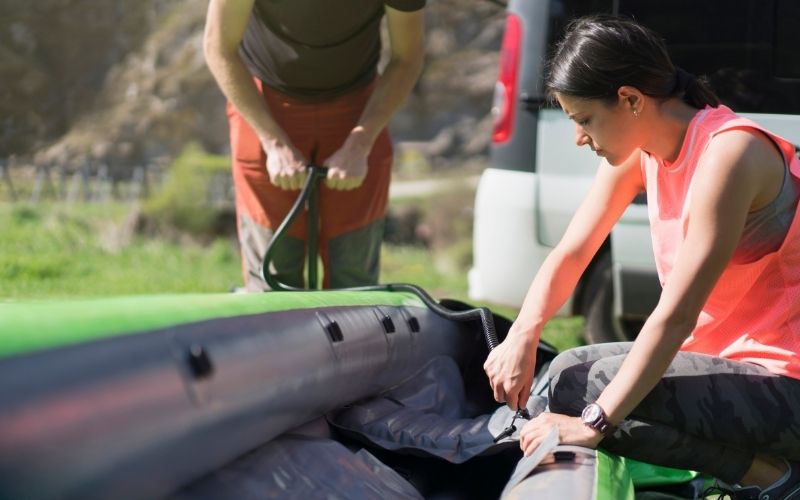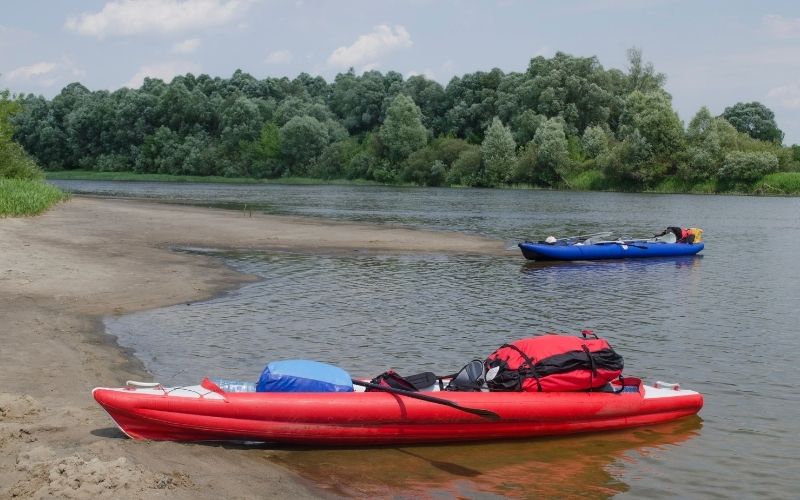So, you just bought a brand new inflatable kayak. Now what?
Obviously, inflatable kayaks are lightweight and don’t take up a lot of storage space, but it does take a bit of preparation to get them ready for use. You have to pump them up.
How much time can you expect to spend inflating your inflatable kayak? How do you do it? Is it possible to over-inflate a kayak, and what are the consequences of doing so?
And can you leave your kayak inflated when you’re not using it?
Keep reading!
This article will explore the answers to all of these questions.
Table of Contents
How Long Does it Take to Pump Up an Inflatable Kayak?

Filling up an inflatable kayak rarely takes long. But just how long can you expect it to take before you’re ready to hit the water?
The exact length of time for inflation will depend on several factors, including:
- Type of pump: There are different types of pumps you can use to fill your kayak. If you have a manual hand or foot pump, you can expect inflation to take a little longer than if you had an automatic electric pump.
- Size of kayak: Some inflatable kayaks are small, made for only a single passenger. Others are heavy-duty tandem kayaks made to haul two or more passengers and a bunch of gear. Smaller kayaks will inflate more quickly than larger kayaks.
- Design and quality of kayak: Some kayaks are designed with multiple air chambers that you may need to inflate separately. These will likely take longer to inflate than kayaks with a single inflatable chamber. Higher-quality kayaks may also take longer to inflate.
- Experience level: If this is your first inflatable kayak and you’ve never pumped one up before, it may take you some extra time to figure out what you’re doing. Once you’ve got the hang of it and have pumped up your kayak several times, it shouldn’t take as long.
Regardless of the factors involved, kayaks don’t take very long to inflate. Generally speaking, pumping up an inflatable kayak can take anywhere from 3 to 15 minutes.
If you’re using an electric pump and you’ve done it many times before, then you should be familiar with the process and it won’t take long at all. This is especially true if you have a small, single-passenger kayak with a single inflatable chamber.
On the other hand, if you’re using a hand pump and it’s your first time inflating a kayak, the process may take longer while you figure out what to do, especially with a large or multi-chamber kayak. Plus, the hand or foot pump will take longer than an electric pump.
How Do You Inflate an Inflatable Kayak?
If this is your first time inflating a kayak, you may find it helpful to watch a tutorial video like the following one before getting started:
Once you’re ready to start inflating your kayak, follow this step-by-step process:
- Lay it out flat: Unfold your kayak on a smooth surface free of sharp debris. Lay it out as flat as possible, being sure to smooth out the creases.
- Locate the pump valves: Most kayaks will have at least two separate air chambers–one for the floor and one for the rest of the kayak. Locate the pump valves for each chamber. Look for a number next to each chamber denoting which one should be inflated first.
- Attach the pump: Depending on the pump and valve type, you may need to screw the tip of the pump onto the valve, or the tip may simply snap into place over the valve. Follow the instructions included with the pump to secure it in place.
- Start pumping: If you’re using an electric pump, plug it in and turn it on–it will begin inflating automatically. If using a hand or foot pump, begin pumping it manually according to the instructions included with the pump.
- Secure the footrest, chair, and skeg: Most kayaks will also come with an inflatable chair and footrest. Pump these up separately and secure them in place as shown in the kayak owner’s manual. Just before putting it in the water, add the skeg to the bottom of the kayak.
What Happens if You Over-Inflate an Inflatable Kayak?

It’s extremely important not to pump too much air into your kayak. Over-inflating any type of inflatable boat can cause several problems, including:
- The boat might pop: It is possible to keep pumping up your boat until it pops. You never want to fill it this full–the boat should feel firm but not hard. If you continue pumping until it gets hard, it could pop either while you’re pumping or, worse, while you’re in the water.
- It could develop weaknesses: Even if the boat doesn’t pop, over-inflating it will weaken the seams. Repeated over-inflations, pressure changes, and even mild impacts could cause the seams to fail, leading to air leaks.
- It is more prone to impact damage: Because of weakened seams and stress on the kayak material, an over-inflated kayak may be more prone to damage from impacts with the riverbed or rocks along the shore.
- It could be more unstable: An over-inflated kayak may be too buoyant, which could cause it to bounce more and become very unstable in the water.
- It could have a shorter lifespan: Over-inflated kayaks, especially those that receive repeated over-inflations, will not last as long as they otherwise would. Repeated impacts and stress on the seams will eventually cause the kayak to fail prematurely.
Can You Leave an Inflatable Kayak Inflated when Not in Use?

Technically, you can, but it’s best to deflate your kayak between uses.
Temperature changes can cause the air pressure to increase inside the kayak, putting stress on the seams and valves, which could weaken them and cause air leaks.
Leaving your kayak inflated may also weaken the material overall, leading to a shorter lifespan and a higher risk of encountering problems out on the water.
Between uses, dry completely and deflate your kayak. Keep it in a cool, dry storage area, away from direct sunlight and animals that could cause damage. It’s best to store the kayak inside, but if you need to store it outside, keep it covered so it will be protected from the elements.
Conclusion
It can take anywhere from 3 to 15 minutes to inflate most kayaks, depending on the type of kayak you have, the type of pump you’re using, and your level of experience. Most inflatable kayaks are easy to pump up, even for beginners.
Always be careful not to over-inflate your kayak, and it is best to deflate it between uses. Be safe and enjoy your time out on the water!

Sarah Hood has been writing for Anchor Travel since 2021. When she’s not writing, she enjoys cooking, singing, and spending time in the great outdoors.

